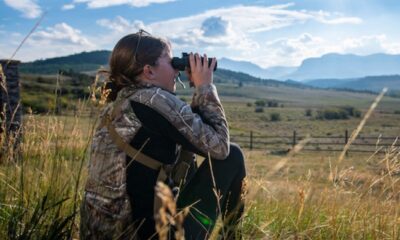Adventure
BOLO: Poacher(s) Kill Two Endangered California Condors

We know who to feed the perpetrator to…
Very few things make me angrier than poaching. One of them is poaching endangered species.
Many hunters (including myself) are willing to give a bit of grace to “mistaken identity” poaching, when the hunter had no intentions of poaching but misidentified their game–say, mistaking a hen turkey (not legal) for a jake (legal). Many of us are also willing to give a bit of grace to subsistence poachers–people, usually impoverished, who take plentiful game (like whitetails) out of season for the sole purpose of eating it.
That’s not what today’s story is about.
Today’s story is about the deaths of two California condors, which are a) so endangered that the world population is under 600 individual birds; and b) completely unmistakable for any other avian, given their unique and enormous size. Whoever shot these condors did so deliberately, and then they left the carcasses to rot.
I’m not making any specific suggestions about what the Utah DWR ought to do about this if the perpetrators are caught. I will, however, note that condors are members of the vulture family. Vultures are scavengers, and they’re incredibly efficient at it. So efficient, in fact, that many cultures worldwide use a unique method of burial for their human dead: Sky burial. That’s when the deceased is simply laid out on a tower or mountainside for the birds to skeletonize in a matter of hours.
Just sayin’.
Here’s the report direct from the Utah DWR, complete with links and phone numbers for tips, should you have any!
~~~~~~~~~~~~~~~~~~~~~~~~~~~~~~~~~~~~
Investigators with the Utah Division of Wildlife Resources and the U.S. Fish and Wildlife Service are seeking information after two California condors were shot and killed in southern Utah in the last two years.
The first California condor was discovered during the fall of 2022 in a remote area southeast of Cedar City and north of Zion National Park. The second condor was discovered last month in the same area. Both birds were shot with firearms. It’s unclear if the two incidents are connected or what type of firearm was used. At this time, previous leads have not yielded results, so the DWR and USFWS are asking the public for information regarding these incidents and those who are responsible.
California condors are listed under the Endangered Species Act as endangered. Because they are protected under the Endangered Species Act, it is illegal for anyone to harass, harm, pursue, hunt, shoot, wound, kill, trap, capture or collect California condors. The individuals involved in killing these birds could face a third-degree felony charge of wanton destruction of protected wildlife, with a maximum fine of $5,000, restitution of $1,500 and a five-year prison sentence.
The historical California condor population declined to just 22 individuals in the wild by 1987. Currently, the California Condor Recovery Program, led by the USFWS, works with many partners to increase populations through captive breeding and release of these protected birds. As of June 2024, there are 85 condors in the wild in the rugged canyon country of northern Arizona and southern Utah. This number declined in 2023 due to impacts from the highly pathogenic avian influenza. The total world population of endangered California condors’ numbers more than 560 individuals, with more than half flying free in Arizona, Utah, California, and Mexico.
“The illegal killing of these two condors is a devastating and unnecessary loss on top of all the recent deaths from the highly pathogenic avian influenza,” DWR Avian Conservation Program Coordinator Russell Norvell said. “Between the two events, we’ve lost more than a decade’s worth of progress in the recovery of this species.”
Anyone with information regarding the illegal killing of these two California condors is encouraged to report it to the DWR and the U.S. Fish and Wildlife Service in one of the following ways:
- By calling the UTiP Hotline at 800-662-3337
- The UTDWR Law Enforcement app
- By texting 847411
- By calling the U.S. Fish and Wildlife Service tip line at 844-397-8477
- Submitting a tip on the U.S. Fish and Wildlife Service website
A reward may be available for information leading to the successful prosecution of those responsible. Requests for confidentiality are respected.
-

 Hiking & Climbing1 month ago
Hiking & Climbing1 month agoWhen Bears Bring the Drama: A Tail—or Should I Say “Tale”?
-

 Camping & Survival4 weeks ago
Camping & Survival4 weeks agoField Dressing 101: Knowing When It’s Their Turn
-

 Adventure2 months ago
Adventure2 months agoNo Ivy Required: University of Montana’s New Center for Hunting and Conservation
-

 Fishing2 months ago
Fishing2 months agoMy Wacky Bush Brings All the Bass to the Yard
-

 Adventure2 weeks ago
Adventure2 weeks agoElk Calling Tips: Essential Guide for First-Time Hunters
-

 Accessories5 days ago
Accessories5 days agoBackcountry Trails 2025: Top 10 Hacks & Gear






